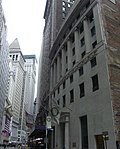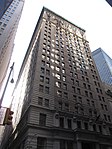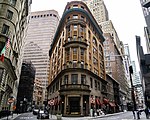55 Broad Street

55 Broad Street is a 30-story building at Broad Street and Beaver Street in the Financial District of Manhattan in New York City, U.S. It adjoins 15 William, a skyscraper to the east. The building was constructed from 1964 to 1967. It operated as the headquarters of the trading firm Goldman Sachs from 1967 to 1983. It continued as an office building afterward. In 2023, a redevelopment effort began which is changing the building from commercial space into residential apartments. The project is expected to create 571 apartments and finish around 2025. The building was owned by the Rudin Management Company from 1964 to 2023; the building was taken over by Silverstein Properties and Metro Loft for the redevelopment effort, although Rudin maintains a stake in the project. Ares Real Estate Group has also invested in the redevelopment venture.
Excerpt from the Wikipedia article 55 Broad Street (License: CC BY-SA 3.0, Authors, Images).55 Broad Street
Broad Street, New York Manhattan
Geographical coordinates (GPS) Address Nearby Places Show on map
Geographical coordinates (GPS)
| Latitude | Longitude |
|---|---|
| N 40.70538662224 ° | E -74.010985521049 ° |
Address
55 Broad Street
Broad Street 55
10004 New York, Manhattan
New York, United States
Open on Google Maps










